| Listing 1 - 10 of 29 | << page >> |
Sort by
|
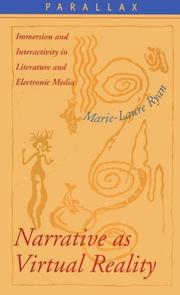
ISBN: 0801864879 0801877539 0801876818 9780801864872 Year: 2001 Publisher: Baltimore, Md Johns Hopkins University Press
Abstract | Keywords | Export | Availability | Bookmark
 Loading...
Loading...Choose an application
- Reference Manager
- EndNote
- RefWorks (Direct export to RefWorks)
Artificial intelligence. Robotics. Simulation. Graphics --- Literature --- Books and reading. --- Interactive multimedia. --- Virtual reality. --- Livres et lecture --- Multimédias interactifs --- Réalité virtuelle --- Books and reading --- Interactive multimedia --- Virtual reality --- 82:659.3 --- Literatuur en massacommunicatie --- 82:659.3 Literatuur en massacommunicatie --- Multimédias interactifs --- Réalité virtuelle --- Hypermedia systems --- Interactive media --- Computer software --- Appraisal of books --- Books --- Choice of books --- Evaluation of literature --- Reading, Choice of --- Reading and books --- Reading habits --- Reading public --- Reading --- Reading interests --- Reading promotion --- Environments, Virtual --- Virtual environments --- Virtual worlds --- Computer simulation --- Reality --- Appraisal --- Evaluation
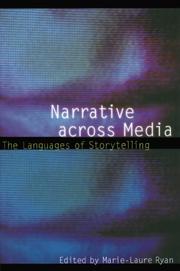
ISBN: 0803239440 0803289936 9780803239449 9780803289932 Year: 2004 Publisher: Lincoln, Neb. University of Nebraska Press
Abstract | Keywords | Export | Availability | Bookmark
 Loading...
Loading...Choose an application
- Reference Manager
- EndNote
- RefWorks (Direct export to RefWorks)
Narratology has been conceived from its earliest days as a project that transcends disciplines and media. The essays gathered here address the question of how narrative migrates, mutates, and creates meaning as it is expressed across various media. Dividing the inquiry into five areas: face-to-face narrative, still pictures, moving pictures, music, and digital media, 'Narrative across Media' investigates how the intrinsic properties of the supporting medium shape the form of narrative and affect the narrative experience. Unlike other interdisciplinary approaches to narrative studies, all of which have tended to concentrate on narrative across language-supported fields, this unique collection provides a much-needed analysis of how narrative operates when expressed through visual, gestural, electronic, and musical means. In doing so, the collection redefines the act of storytelling. Although the fields of media and narrative studies have been invigorated by a variety of theoretical approaches, this volume seeks to avoid a dominant theoretical bias by providing instead a collection of concrete studies that inspire a direct look at texts rather than relying on a particular theory of interpretation. A contribution to both narrative and media studies, 'Narrative across Media' is the first attempt to bridge the two disciplines.
storytelling --- Fiction --- Literary rhetorics --- Mass communications --- Narration (Rhetoric) --- Mass media --- narratologie --- literatuur --- woord en beeld --- schilderkunst --- beeldhouwkunst --- graphic novels --- Maus --- Spiegelman Art --- filmtheorie --- reality tv --- muziek --- nieuwe media --- computerspellen --- interactiviteit --- 7.01 --- 82-3 --- Proza. Fictie. Narratologie --- Athapascan Indians --- Athapascan mythology. --- Mass media. --- Tales --- Narration (Rhetoric). --- 82-3 Proza. Fictie. Narratologie --- Narrative (Rhetoric) --- Narrative writing --- Rhetoric --- Discourse analysis, Narrative --- Narratees (Rhetoric) --- Mass communication --- Media, Mass --- Media, The --- Communication --- 82-3 Fiction. Prose narrative --- Fiction. Prose narrative

ISBN: 0253350042 9780253350046 Year: 1991 Publisher: Bloomington, Ind. Indiana University Press
Abstract | Keywords | Export | Availability | Bookmark
 Loading...
Loading...Choose an application
- Reference Manager
- EndNote
- RefWorks (Direct export to RefWorks)
Linguistics --- Fiction --- Lexicology. Semantics --- Artificial intelligence. Robotics. Simulation. Graphics --- Literary semiotics --- Thematology --- Possibility in literature --- Artificial intelligence --- Narration (Rhetoric) --- Semiotics and literature --- Technique --- 82-3 --- -Narration (Rhetoric) --- Literature and semiotics --- Literature --- Narrative (Rhetoric) --- Narrative writing --- Rhetoric --- Discourse analysis, Narrative --- Narratees (Rhetoric) --- Metafiction --- Novellas (Short novels) --- Novels --- Stories --- Novelists --- AI (Artificial intelligence) --- Artificial thinking --- Electronic brains --- Intellectronics --- Intelligence, Artificial --- Intelligent machines --- Machine intelligence --- Thinking, Artificial --- Bionics --- Cognitive science --- Digital computer simulation --- Electronic data processing --- Logic machines --- Machine theory --- Self-organizing systems --- Simulation methods --- Fifth generation computers --- Neural computers --- Proza. Fictie. Narratologie --- Philosophy --- Artificial intelligence. --- Possibility in literature. --- Semiotics and literature. --- Technique. --- Narration (Rhetoric). --- 82-3 Proza. Fictie. Narratologie --- Fiction writing --- Writing, Fiction --- Authorship --- Narration --- Possibilité --- Intelligence artificielle --- Sémiotique et littérature --- Possibilité --- Sémiotique et littérature
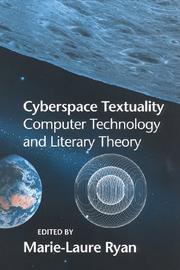
ISBN: 0253212421 Year: 1999 Publisher: Bloomington Indianapolis Indiana University Press
Abstract | Keywords | Export | Availability | Bookmark
 Loading...
Loading...Choose an application
- Reference Manager
- EndNote
- RefWorks (Direct export to RefWorks)
Computers and civilization --- Computers en beschaving --- Ordinateurs et civilisation --- 82.0 --- 82:1 --- 82:62 --- Literatuurtheorie --- Literatuur en filosofie --- Literatuur en technologie --- Computers and civilization. --- Electronic publications --- Literature --- Philosophy. --- 82:62 Literatuur en technologie --- 82:1 Literatuur en filosofie --- 82.0 Literatuurtheorie --- Literature and philosophy --- Philosophy and literature --- Online publications --- Digital media --- Publications --- Civilization and computers --- Civilization --- Philosophy --- Theory --- Electronic publishing
Book
ISBN: 9781421417974 1421417979 Year: 2015 Publisher: Baltimore : John Hopkins University Press,
Abstract | Keywords | Export | Availability | Bookmark
 Loading...
Loading...Choose an application
- Reference Manager
- EndNote
- RefWorks (Direct export to RefWorks)
When the first edition was written, the dominant form of electronic literature was hypertext fiction. The book devoted several chapters to hypertext theory, as well as to the difficulty of creating immersive hypertext narratives. Hypertextuality has lost none of its prominence as a principle of organization of the Web, but it is no longer considered avant-garde on the digital-literary scene. While the new forms that are currently being developed verify some of the recommendations made in NVR (shorter texts, greater reliance on multi-modality, self-referentiality and a tendency toward conceptual art), they generally avoid narrativity and its particular form of immersion, and even interactivity is no longer seen as indispensable. It is in the popular form of the video game that serious attempts are being made to reconcile immersion with interactivity. The second edition deals in greater detail with both the increase of narrativity in video games, and its loss in experimental digital literature. It also takes into consideration the creation of online worlds such as Second Life and World of Warcraft, which implement the idea of virtual reality in a way not foreseen by VR theorists of the nineties.
Books and reading. --- Hypertext literature. --- Electronic games. --- Interactive multimedia. --- Virtual reality. --- Rhetoric --- Livres et lecture --- Littérature numérique --- Jeux électroniques --- Multimédias interactifs --- Réalité virtuelle --- Rhétorique --- Littérature et informatique --- Narration --- Littérature numérique --- Jeux électroniques --- Multimédias interactifs --- Réalité virtuelle --- Rhétorique --- Livres et lecture. --- Narration. --- Jeux électroniques. --- Littérature et informatique. --- Multimédias interactifs. --- Réalité virtuelle. --- Electronic games --- Interactive multimedia --- Hypertext literature --- Virtual reality --- Narration (Rhetoric) --- Books and reading --- Narration (Rhetoric). --- Video games.
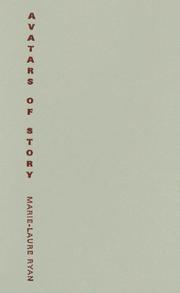
ISBN: 0816646856 9780816646852 0816646864 9780816646869 0816697868 Year: 2006 Publisher: Minneapolis University of Minnesota press
Abstract | Keywords | Export | Availability | Bookmark
 Loading...
Loading...Choose an application
- Reference Manager
- EndNote
- RefWorks (Direct export to RefWorks)
Narration (Rhetoric) --- Interactive multimedia --- narratologie --- televisie --- reality tv --- filmtheorie --- internet --- computerspellen --- literatuur --- interactiviteit --- nieuwe media --- multimedia --- 791.5 --- 82:659.3 --- 82:62 --- 82-3 --- Literatuur en massacommunicatie --- Literatuur en technologie --- Proza. Fictie. Narratologie --- Interactive multimedia. --- Narration (Rhetoric). --- 82-3 Proza. Fictie. Narratologie --- 82:62 Literatuur en technologie --- 82:659.3 Literatuur en massacommunicatie --- Narrative (Rhetoric) --- Narrative writing --- Rhetoric --- Discourse analysis, Narrative --- Narratees (Rhetoric) --- Hypermedia systems --- Interactive media --- Computer software --- 82-3 Fiction. Prose narrative --- Fiction. Prose narrative
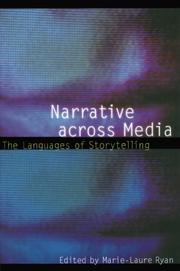
ISBN: 9780803289932 Year: 2004 Publisher: Lincoln University of Nebraska Press
Abstract | Keywords | Export | Availability | Bookmark
 Loading...
Loading...Choose an application
- Reference Manager
- EndNote
- RefWorks (Direct export to RefWorks)
Storytelling --- MAD-faculty 13 --- literaire analyse --- verteltheorie
Book
ISBN: 9780814215081 9780814282274 0814215084 Year: 2022 Publisher: Columbus, Ohio The Ohio State University Press
Abstract | Keywords | Export | Availability | Bookmark
 Loading...
Loading...Choose an application
- Reference Manager
- EndNote
- RefWorks (Direct export to RefWorks)
The question of how narratives actually do the work of world-building transcends disciplines: from cosmology to philosophy, digital culture, popular culture, and literary theory. In A New Anatomy of Storyworlds, Marie-Laure Ryan investigates the narratological importance of the concept of world in its various manifestations. She uses a wide array of works—from Sokal’s hoax to Maus, from Saussure to Barthes, from Kafka to virtual reality—to interrogate key narratological concepts. By revisiting and redefining concepts such as narrator, plot, character, fictionality, mimesis, and diegesis, Ryan reexamines the major controversies that have enlivened narratology: Does narrative necessarily involve a narrator? Is the notion of implied author useful? Do texts that challenge our experience of the real world require a different narratology? Is the distinction between fictional and factual narratives gradual or binary? Ultimately, Ryan grounds narratology in the concept of world to propose an alternative to the rhetorical, feminist, unnatural, and cognitive approaches that currently dominate the field, thus broadening the frame through which we view story and world-building.
Pragmatics --- Fiction --- Narration (Rhetoric) --- Discourse analysis, Narrative --- Rhetoric --- Narratees (Rhetoric) --- History and criticism --- Discourse analysis, Narrative. --- History and criticism.
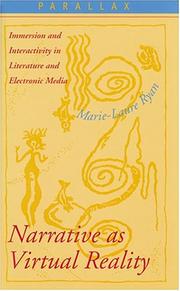
ISBN: 9780801877537 Year: 2001 Publisher: Baltimore (Md) Johns Hopkins University Press
Abstract | Keywords | Export | Availability | Bookmark
 Loading...
Loading...Choose an application
- Reference Manager
- EndNote
- RefWorks (Direct export to RefWorks)
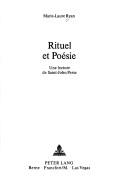
ISBN: 3261019506 Year: 1977 Publisher: Berne
Abstract | Keywords | Export | Availability | Bookmark
 Loading...
Loading...Choose an application
- Reference Manager
- EndNote
- RefWorks (Direct export to RefWorks)
| Listing 1 - 10 of 29 | << page >> |
Sort by
|

 Search
Search Feedback
Feedback About UniCat
About UniCat  Help
Help News
News